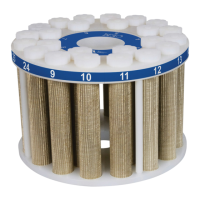16 Cleaning and Inspection
Cleaning and Inspection
WARNING
Proper precautions must be taken to avoid contact with acids or acid vapors. Protective gear should be
worn as outlined in the user’s safety program for hazardous materials and the acid manufacturer’s safety
data sheet. Refer to these guidelines for proper handling and disposal of the acids.
Liners, Vent Plugs, and Caps
1. Rinse the liners with deionized water and allow to dry completely before use.
2. If measuring ppm, ppb and/or ppt analyte levels, proceed with steps below.
3. Clean liners with hot, soapy water and foam brush. Rinse thoroughly with deionized water and allow to dry
completely before use.
NOTE
Micro-90® cleaning solution works well on Teon. Avoid detergents that contain ingredients that could
cause potential contamination such as Na and P. Avoid abrasive cleansers and stiff brushes which can
scratch the Teon surface.
4. Clean liners using the microwave as outlined below. All vessel components must be dry before use.
4.1. Add 10 mL of acid type that had been used for sample digestion, HNO
3
, HCl, H
2
SO
4
, H
3
PO
4
or HF.
4.2. Prepare vessel and turntable as outlined in manual.
4.3. Select and run the "Xpress Clean" method in the One Touch directory.
4.4. Wait for vessels to cool for a minimum of 15 minutes before opening microwave door.
4.5. Discard acid and rinse the liners and covers with deionized water.
5. Inspect liners.
• Liners should be smooth and white.
• Liners that are bowed, deformed, stretched or compressed, need to be discarded.
• Do not mix new and discolored liners in the same batch. See “Liner Bake-out procedure” below to restore
discolored liners.
Liner Bake-out Procedure
As needed: The bake-out procedure can be used to remove residual acid vapors and other trapped gases from the
Teon® material. Trapped gases can potentially cause uneven heating between new and used liners.
The bake-out procedure can be used to remove residual NO
x
gases from liners following digestion with HNO
3
that
may interfere in subsequent runs. This procedure has been successfully used to remove sulfur contamination from
the Teon following digestion of samples with high sulfur content.
1. Place the liners on their side in an air oven at room temperature.

